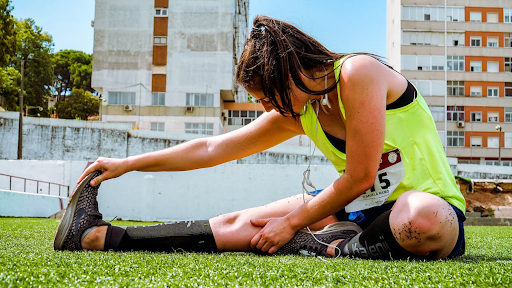In recent years, dynamic stretching has gained recognition as the best stretching method to prepare for sports; but in the meantime, many people took this to mean that static stretching is “bad.”
Is static stretching truly bad?
Does static stretching negatively impact performance?
Should static stretching be avoided altogether?
In this article, we discuss how static stretching got its reputation for negatively impacting performance and whether this belief has been taken out of context in the mainstream. We reveal the advantages of static stretching and how you can still use this method to improve range of motion and flexibility, reduce injuries, enhance performance, facilitate recovery, and benefit overall wellness and longevity.
How Did Static Stretching Get Labeled “Bad”?
When researchers began comparing static vs. dynamic stretching, there was evidence showing that static stretching performed immediately before an explosive activity, such as a sprint, might actually negatively impact sprint-time, or performance. Without going into the science too deeply, the explanation behind this finding is that a prolonged static stretch may actually relax a muscle too much, reducing the elasticity and springiness that facilitates a muscle’s quick transfer of energy, which contributes to reaction time and muscle contraction. The consequence was reduced quickness or power output in the activity immediately following the static stretch.
When news spread to the mainstream that static stretching may negatively impact performance, people took this information out of context and began avoiding static stretching altogether, believing it to be “bad.”
However, the research must be kept in context, which specifies that performance in an explosive event may be reduced in the moments immediately following a static stretch. The research does not conclude that static stretching will negatively impact all aspects of sports performance and general wellness.
Consider this example of a sprinter. Would a sprinter benefit from better mobility, range of motion, flexibility, and recovery? Yes, of course! So, while a sprinter might want to focus on dynamic stretching during the few minutes right before the event, static stretching should still be utilized at the right time, such as after the event, when the body is warm, or at another point during training.
Unfortunately, I frequently hear phrases like this from coaches and parents:
“We stopped all static stretching,” and “Static stretching is bad, so we don’t do it anymore.”
In order to function properly, muscles need to be able to lengthen, shorten, and broaden; and a muscle’s ability to lengthen is known as flexibility. A joint’s ability to move limbs is called range of motion. Greater range of motion and flexibility lead to higher performance, more resilience, better neural activation integrity, and overall improved longevity.
Static Stretching Is Not Bad
Let’s dive deeper into this controversy to understand that static stretching still has an incredibly valuable role in performance, wellness, and injury prevention, and is actually the preferred type of stretching for long-term gains in range of motion and flexibility.
When performed correctly and at the appropriate time, static stretching has been shown to:
- Improve range of motion and flexibility
- Reduce the risk of injury
- Activate neural connections
- Enhance performance
- Promote recovery
- Reduce pain
- Promote relaxation and mental focus
- Benefit overall wellness and longevity
The key is to incorporate static stretching consistently into a well-rounded training routine.
Best Parameters For Static Stretching
Research shows that static stretching is superior to other forms of stretching, including dynamic, ballistic, and PNF methods, when the goal is to make long-term gains in limb range of motion and flexibility.
The next questions become, when is the best time to do static stretching, how long to hold, and how often?
- Again, following the research, the optimal time to static stretch is after cardiovascular activity, when the body is warm. This could be after 5 minutes of light jogging or calisthenics, or after playing a sport, such as soccer, basketball, or pickleball.
- Holding a static stretch for 30 seconds has been shown to be the necessary amount of time to sustain a stretch. Interestingly, longer sustained holds are not necessarily more effective in terms of making long-term gains in flexibility.
- 5 minutes of static stretching per week is optimal, and must be spread out over multiple days.
- Research shows that following the parameters above, 5 times per week for 6 weeks, results in a 20% increase in limb range of motion.
Now let’s recap this and keep it realistic for a busy lifestyle: A good, evidence-based suggestion to improve range of motion and flexibility of a muscle group, or to fix “tight” muscles, is to hold a static stretch for 30 seconds, repeating 2-4 times, and performing 3 times per week for 6 weeks.
If you still believe that static stretching is bad, then I encourage you to think bigger. Enhancing performance is more than just what you do in the 90 seconds immediately before a race. Preventing injuries is more than just a pre-game routine. Flexibility and range of motion hold massive benefits and can be improved long-term with consistent static stretching.
Incorporating static stretching into your routine can have a profound impact on athletic performance and overall well-being. While it may be overshadowed by dynamic warm-ups in the mainstream trends, understanding that you SHOULD continue with static stretching is critical right now.
Truthfully, there are numerous training strategies to choose from, with pros and cons to everything; and that’s why we incorporate both static and dynamic stretches into our ACL Strong programs, as well as a variety of strength, balance, and stability exercises. We typically do dynamic stretches before the ACL Strong exercises, and static stretching at the end. It works for us, our patients, and our ACL Strong members.
When you are ready, we can help you or your athletes prevent injuries and enhance performance by doing the right exercises, the right way, without figuring it out on your own.
Check out our signature courses to get stronger, quicker, more bulletproof, and simply better at your sport with a step-by-step proven training system, so you don’t have to figure it out on your own, and you can focus on your game and your future.



